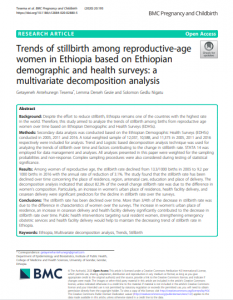
Background
Despite the effort to reduce stillbirth, Ethiopia remains one of the countries with the highest rate in the world. Therefore, this study aimed to analyze the trends of stillbirth among births from reproductive age women over time based on Ethiopian Demographic and Health Surveys (EDHSs).
Methods
Secondary data analysis was conducted based on the Ethiopian Demographic Health Surveys (EDHSs) conducted in 2005, 2011 and 2016. A total weighted sample of 12,037, 10,588, and 11,375 in 2005, 2011 and 2016 respectively were included for analysis. Trend and Logistic based decomposition analysis technique was used for analyzing the trends of stillbirth over time and factors contributing to the change in stillbirth rate. STATA 14 was employed for data management and analyses. All analyses presented in this paper were weighted for the sampling probabilities and non-response. Complex sampling procedures were also considered during testing of statistical significance.
Results
Among women of reproductive age, the stillbirth rate declined from 13.3/1000 births in 2005 to 9.2 per 1000 births in 2016 with the annual rate of reduction of 3.1%. The study found that the stillbirth rate has been declined over time concerning the place of residence, region, antenatal care, education and place of delivery. The decomposition analysis indicated that about 82.3% of the overall change stillbirth rate was due to the difference in women’s composition. Particularly, an increase in women’s urban place of residence, health facility delivery, and cesarean delivery were significant predictors for the decline in stillbirth rate over the surveys.
Conclusions
The stillbirth rate has been declined over time. More than 3/4th of the decrease in stillbirth rate was due to the difference in characteristics of women over the surveys. The increase in women’s urban place of residence, an increase in cesarean delivery and health facility delivery significantly contributed to the decrease in stillbirth rate over time. Public health interventions targeting rural resident women, strengthening emergency obstetric services and health facility delivery would help to maintain the decreasing trend of stillbirth rate in Ethiopia.